Showing Spotlights 169 - 176 of 240 in category All (newest first):
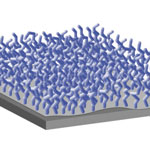 Unlike most biological membranes, polymeric, nanometer-thin membranes are very stable and can withstand considerable pressure. This is an essential requirements for separation processes such as in water purification and desalination. Because their mechanical stability can be combined with flexibility and chemical functionality, polymer nanomembranes are also intensely researchers as materials for actuators and microsensors. They have also entered the biomedical field as artificial nacre and as a novel material used in surgery. Crosslinking of a spin-coated precursor solution, a common fabrication technique, reduces the interactions between the polymer chains and the environment and thus impairs the sensitivity and flexibility of the films. Researchers in Germany have now developed the first freestanding polymer brush, grafted from a crosslinked monolayer (nanosheet) that provides mechanical stability and structural integrity.
Unlike most biological membranes, polymeric, nanometer-thin membranes are very stable and can withstand considerable pressure. This is an essential requirements for separation processes such as in water purification and desalination. Because their mechanical stability can be combined with flexibility and chemical functionality, polymer nanomembranes are also intensely researchers as materials for actuators and microsensors. They have also entered the biomedical field as artificial nacre and as a novel material used in surgery. Crosslinking of a spin-coated precursor solution, a common fabrication technique, reduces the interactions between the polymer chains and the environment and thus impairs the sensitivity and flexibility of the films. Researchers in Germany have now developed the first freestanding polymer brush, grafted from a crosslinked monolayer (nanosheet) that provides mechanical stability and structural integrity.
Sep 2nd, 2010
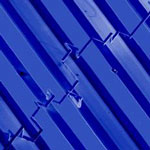 Imagine a device the size of - and nearly as cheap as - a grain of sand which is capable of analyzing the environment around it, recognize its chemical composition, and report it to a monitoring system. This is the concept of nanotechnology-based electronic noses (e-nose) - miniature electronic devices which mimic the olfactory systems of mammals and insects and which will lead to better, cheaper and smaller sensor devices. An international team of researchers has made a further step towards this vision and demonstrated a novel analytical sensor which mimics our olfaction system. The difference between this and similar prior e-noses is that the active element of this new device is an individual wedge-like nanowire (nanobelt) made of tin dioxide. The required diversity of the sensing elements is encoded in the nanobelt morphology via longitudinal width variations of the nanobelt realized during its growth and via functionalization of some of the segments with palladium catalyst.
Imagine a device the size of - and nearly as cheap as - a grain of sand which is capable of analyzing the environment around it, recognize its chemical composition, and report it to a monitoring system. This is the concept of nanotechnology-based electronic noses (e-nose) - miniature electronic devices which mimic the olfactory systems of mammals and insects and which will lead to better, cheaper and smaller sensor devices. An international team of researchers has made a further step towards this vision and demonstrated a novel analytical sensor which mimics our olfaction system. The difference between this and similar prior e-noses is that the active element of this new device is an individual wedge-like nanowire (nanobelt) made of tin dioxide. The required diversity of the sensing elements is encoded in the nanobelt morphology via longitudinal width variations of the nanobelt realized during its growth and via functionalization of some of the segments with palladium catalyst.
Jul 28th, 2010
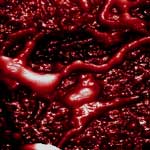 Glass fibers are a widely used reinforcing agent for many materials, from polymers to concrete. The most prominent glass fiber composite is fiberglass, a glass-reinforced plastic. The performance of the glass fiber composite over time depends on the durability of the polymer matrix and the fiber fracture behavior of the material. Since a conventional glass fiber is electrically insulating, traditionally, the monitoring for composite damage has been conducted by external sensors - a technique that degrades the mechanical properties of the material's structure and increases the cost. Researchers have therefore been working on the development of electrically conductive glass fiber plastics by adding conductive particles such as carbon blacks and carbon nanotubes to a polymer matrix. Researchers have now demonstrated a simple approach to deposit carbon nanotube networks onto glass fiber surfaces, thereby achieving semiconductive MWCNT-glass fibers.
Glass fibers are a widely used reinforcing agent for many materials, from polymers to concrete. The most prominent glass fiber composite is fiberglass, a glass-reinforced plastic. The performance of the glass fiber composite over time depends on the durability of the polymer matrix and the fiber fracture behavior of the material. Since a conventional glass fiber is electrically insulating, traditionally, the monitoring for composite damage has been conducted by external sensors - a technique that degrades the mechanical properties of the material's structure and increases the cost. Researchers have therefore been working on the development of electrically conductive glass fiber plastics by adding conductive particles such as carbon blacks and carbon nanotubes to a polymer matrix. Researchers have now demonstrated a simple approach to deposit carbon nanotube networks onto glass fiber surfaces, thereby achieving semiconductive MWCNT-glass fibers.
Jun 30th, 2010
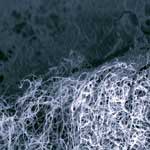 Electrically conductive composite materials capable of substantial elastic stretch and bending - conductive rubbers - is an industrially important field. The composites are needed for such applications as smart clothing, flexible displays, stretchable circuits, strain gauges, implantable devices, high-stroke microelectromechanical systems, and actuators. A variety of approaches involving carbon nanotubes and elastic polymers have been suggested for the fabrication of conductive elastic composites. Various studies indicated that high loading of CNTs or other conductive additives into the polymer was necessary to obtain a highly conducting composite. A research team has now demonstrated that a combination of high stretchability and high electrical conductivity can be obtained for composites prepared from three-dimensional CNT structures.
Electrically conductive composite materials capable of substantial elastic stretch and bending - conductive rubbers - is an industrially important field. The composites are needed for such applications as smart clothing, flexible displays, stretchable circuits, strain gauges, implantable devices, high-stroke microelectromechanical systems, and actuators. A variety of approaches involving carbon nanotubes and elastic polymers have been suggested for the fabrication of conductive elastic composites. Various studies indicated that high loading of CNTs or other conductive additives into the polymer was necessary to obtain a highly conducting composite. A research team has now demonstrated that a combination of high stretchability and high electrical conductivity can be obtained for composites prepared from three-dimensional CNT structures.
May 21st, 2010
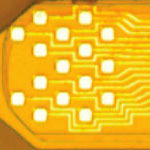 One of the most neglected aspects in the nanoelectronics field is the problem of wiring. How do we wire individual nanoelectronic devices within a nanointegrated circuit together? Furthermore, how do we extract and input information from such a circuit - i.e. how do we let it communicate with the outside world? Researchers at Caltech present a method for multiplexing the electrical signals from potentially tens of thousands of nanoscale sensors onto a single optical output, using piezoelectric nanoscale mechanical resonators. This work is a step closer to building miniscule, highly integrated sensor arrays that are untethered from the external environment.
One of the most neglected aspects in the nanoelectronics field is the problem of wiring. How do we wire individual nanoelectronic devices within a nanointegrated circuit together? Furthermore, how do we extract and input information from such a circuit - i.e. how do we let it communicate with the outside world? Researchers at Caltech present a method for multiplexing the electrical signals from potentially tens of thousands of nanoscale sensors onto a single optical output, using piezoelectric nanoscale mechanical resonators. This work is a step closer to building miniscule, highly integrated sensor arrays that are untethered from the external environment.
Apr 30th, 2010
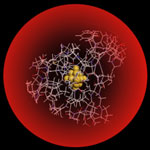 Nanotechnology can play an important role in water treatment and an active emerging area of research is the development of novel nanomaterials with increased affinity, capacity, and selectivity for heavy metals and other contaminants. The benefits from use of nanomaterials may derive from their enhanced reactivity, surface area and sequestration characteristics. In addition to heavy-metal ions such as mercury or lead, toxic anions like cyanide are of concern to environmental managers. Whereas toxic metals induce diseases by accumulating in the body, cyanide can directly cause death in as short a period as minutes by directly affecting the central nervous system. Researchers in China have now developed a relatively simple, cost-effective, environmentally friendly and yet highly sensitive cyanide sensor to test water samples.
Nanotechnology can play an important role in water treatment and an active emerging area of research is the development of novel nanomaterials with increased affinity, capacity, and selectivity for heavy metals and other contaminants. The benefits from use of nanomaterials may derive from their enhanced reactivity, surface area and sequestration characteristics. In addition to heavy-metal ions such as mercury or lead, toxic anions like cyanide are of concern to environmental managers. Whereas toxic metals induce diseases by accumulating in the body, cyanide can directly cause death in as short a period as minutes by directly affecting the central nervous system. Researchers in China have now developed a relatively simple, cost-effective, environmentally friendly and yet highly sensitive cyanide sensor to test water samples.
Apr 8th, 2010
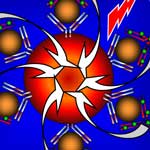 In many diagnostic processes, the detection of several protein markers is required. Rather than performing several sequential analysis steps, a multiplexed approach allows the simultaneous measurement of multiple biomarkers from the same blood sample. The convergence of nanotechnology, microtechnology, microfluidics, photonics, signal processing, and proteomics allows for the development of increasingly sophisticated and effective multiplexed point-of-care diagnostic devices. The detection of protein biomarkers can done with an optical multiplexing approach that uses dye particles of different colors. In contrast to conventional fluorescence dyes, quantum dots generate a much more powerful fluorescent signal which provides a large increase in sensitivity compared to other methods. Quantum dots are also available in multiple colors, allowing the investigators to tag each antibody with a uniquely colored quantum dot. Researchers have now demonstrated a novel and fast quantum dot-based FRET technique that is suitable for multiplexed ultrasensitive detection.
In many diagnostic processes, the detection of several protein markers is required. Rather than performing several sequential analysis steps, a multiplexed approach allows the simultaneous measurement of multiple biomarkers from the same blood sample. The convergence of nanotechnology, microtechnology, microfluidics, photonics, signal processing, and proteomics allows for the development of increasingly sophisticated and effective multiplexed point-of-care diagnostic devices. The detection of protein biomarkers can done with an optical multiplexing approach that uses dye particles of different colors. In contrast to conventional fluorescence dyes, quantum dots generate a much more powerful fluorescent signal which provides a large increase in sensitivity compared to other methods. Quantum dots are also available in multiple colors, allowing the investigators to tag each antibody with a uniquely colored quantum dot. Researchers have now demonstrated a novel and fast quantum dot-based FRET technique that is suitable for multiplexed ultrasensitive detection.
Feb 17th, 2010
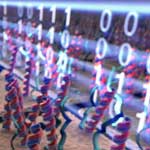 Much of today's genetic research and diagnostics uses tools and technologies enabled by DNA's ability to bind to its complementary strand in a sequence specific manner. For biologists studying molecular mechanisms inside cells, this information helps to quantify the expression levels of genes. Detection of the binding - or hybridization - of DNA strands is at the heart of modern medicine. The technology for detecting DNA hybridization mainly relies on the use of fluorescent labels. The complementary strand coming from the sample bears a label, so detection of florescence signal indicates hybridization. While this may sound straightforward, it has major limitations. Researchers have now reported a new technique for genetic analysis using nanomechanical response of hybridized DNA/RNA molecules. This new technique is several orders of magnitude more sensitive than other approaches and it is a lot simpler to use.
Much of today's genetic research and diagnostics uses tools and technologies enabled by DNA's ability to bind to its complementary strand in a sequence specific manner. For biologists studying molecular mechanisms inside cells, this information helps to quantify the expression levels of genes. Detection of the binding - or hybridization - of DNA strands is at the heart of modern medicine. The technology for detecting DNA hybridization mainly relies on the use of fluorescent labels. The complementary strand coming from the sample bears a label, so detection of florescence signal indicates hybridization. While this may sound straightforward, it has major limitations. Researchers have now reported a new technique for genetic analysis using nanomechanical response of hybridized DNA/RNA molecules. This new technique is several orders of magnitude more sensitive than other approaches and it is a lot simpler to use.
Dec 21st, 2009
 Unlike most biological membranes, polymeric, nanometer-thin membranes are very stable and can withstand considerable pressure. This is an essential requirements for separation processes such as in water purification and desalination. Because their mechanical stability can be combined with flexibility and chemical functionality, polymer nanomembranes are also intensely researchers as materials for actuators and microsensors. They have also entered the biomedical field as artificial nacre and as a novel material used in surgery. Crosslinking of a spin-coated precursor solution, a common fabrication technique, reduces the interactions between the polymer chains and the environment and thus impairs the sensitivity and flexibility of the films. Researchers in Germany have now developed the first freestanding polymer brush, grafted from a crosslinked monolayer (nanosheet) that provides mechanical stability and structural integrity.
Unlike most biological membranes, polymeric, nanometer-thin membranes are very stable and can withstand considerable pressure. This is an essential requirements for separation processes such as in water purification and desalination. Because their mechanical stability can be combined with flexibility and chemical functionality, polymer nanomembranes are also intensely researchers as materials for actuators and microsensors. They have also entered the biomedical field as artificial nacre and as a novel material used in surgery. Crosslinking of a spin-coated precursor solution, a common fabrication technique, reduces the interactions between the polymer chains and the environment and thus impairs the sensitivity and flexibility of the films. Researchers in Germany have now developed the first freestanding polymer brush, grafted from a crosslinked monolayer (nanosheet) that provides mechanical stability and structural integrity.
 Subscribe to our Nanotechnology Spotlight feed
Subscribe to our Nanotechnology Spotlight feed





